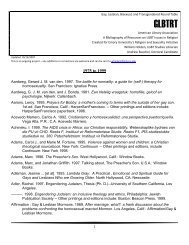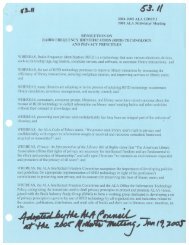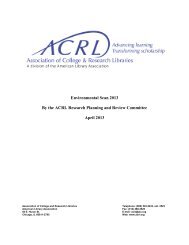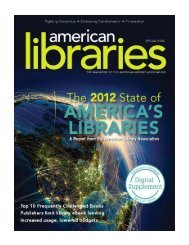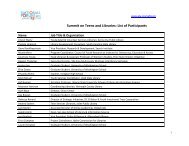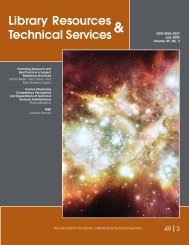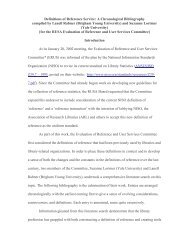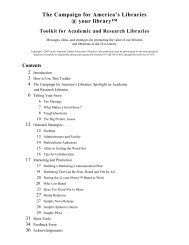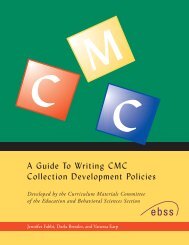Toolkit for School Library Media Programs - American Library ...
Toolkit for School Library Media Programs - American Library ...
Toolkit for School Library Media Programs - American Library ...
You also want an ePaper? Increase the reach of your titles
YUMPU automatically turns print PDFs into web optimized ePapers that Google loves.
Many public and academic libraries have discovered the<br />
advantages of having a Friends’ group to support their<br />
programs. These include:<br />
● Help with fundraising via membership dues, book<br />
sales, other projects;<br />
● Assistance with special projects and programs;<br />
● Advocating <strong>for</strong> support of the school library media<br />
program.<br />
Forming a Friends group can be a key strategy in raising<br />
awareness of the library media program, its contributions<br />
and needs by engaging parents, school staff and others<br />
in its support. It is also an effective way to nurture a core<br />
group of advocates in good times, as well as bad.<br />
Recruiting members will be easier if you have already<br />
begun to establish a higher profile <strong>for</strong> the school library<br />
media program. You will also want to get the<br />
endorsement of school administrators. In approaching<br />
them, it may be helpful to submit a brief one-page<br />
proposal outlining how the group would work, its goals,<br />
purpose, membership and, most important, the<br />
advantages it would offer.<br />
26<br />
Friends of Libraries USA, a national organization that<br />
provides support to local Friends groups, offers the<br />
following advice <strong>for</strong> organizing a Friends of a <strong>School</strong><br />
<strong>Library</strong>.<br />
1. Determine the purpose of the group. The goal<br />
might be the improvement of the library<br />
media program. Objectives might include<br />
<strong>for</strong>ming a volunteer group or involvement of<br />
parents, children, alumni and faculty.<br />
2. Identify and develop a core of lay leaders. The<br />
librarian and administration are resources<br />
whose involvement and approval are crucial<br />
to success.<br />
3. Acquaint the Friends with the basic<br />
philosophy and requirements <strong>for</strong> an effective<br />
media program. Define organizational<br />
structure, dues structure.<br />
4. Plan an orientation program/welcome event<br />
<strong>for</strong> new members. Explain school policies and<br />
procedures, pertinent state and national<br />
standards.<br />
5. Develop a communication plan <strong>for</strong> a<br />
membership recruitment campaign. Identify<br />
potential members and strategies <strong>for</strong> reaching<br />
them, e.g. news items in parent and faculty<br />
newsletters and presentations to parent<br />
groups about how school libraries can make a<br />
difference in the education of children.<br />
6. Keep records and periodically evaluate the<br />
program.<br />
7. Recognize and thank your Friends and<br />
volunteers.<br />
8. Decide if Junior Friends (<strong>for</strong> students) should<br />
be an adjunct program.<br />
For more in<strong>for</strong>mation, including membership, see<br />
the FOLUSA Web site at www.folusa.org.



